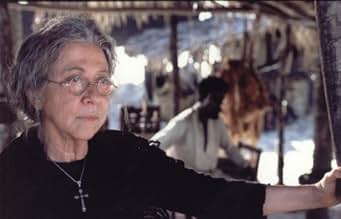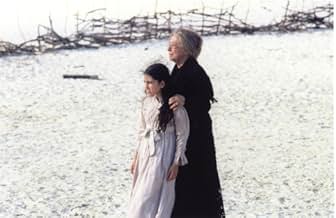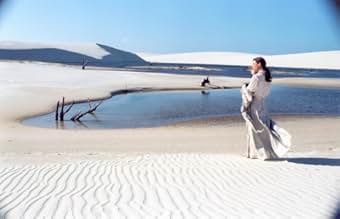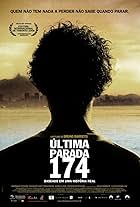VALUTAZIONE IMDb
7,3/10
3302
LA TUA VALUTAZIONE
Aggiungi una trama nella tua linguaA woman is taken along with her mother in 1910 to a far-away desert by her husband, and after his passing, is forced to spend the next 59 years of her life hopelessly trying to escape it.A woman is taken along with her mother in 1910 to a far-away desert by her husband, and after his passing, is forced to spend the next 59 years of her life hopelessly trying to escape it.A woman is taken along with her mother in 1910 to a far-away desert by her husband, and after his passing, is forced to spend the next 59 years of her life hopelessly trying to escape it.
- Premi
- 12 vittorie e 43 candidature
Enrique Diaz
- Luiz - 1919
- (as Enrique Díaz)
Trama
Lo sapevi?
- QuizDuring the first part of the movie (1910-1919), Fernanda Montenegro plays the part of Dona Maria, and her real-life daughter, Fernanda Torres plays the part of her daughter Áurea. As the movie jumps to 1942, Montenegro now plays the part of Áurea, and Torres plays the part of Áurea's daughter, Maria. When the movie jumps again to 1969, Fernanda Montenegro plays the part of both Áurea and Maria.
- BlooperThe movie takes pains to make reference to real events. However, the location marker erected for the scientific party at the total solar eclipse shows the wrong date. It should be 29.05.1919.
- Colonne sonorePrelude Opus 28, nº 15
by Frédéric Chopin
Recensione in evidenza
In Brazilian director Andrucha Waddington's House of Sand/Casa de Areia a mother and her grown daughter, Áurea, are brought into the desert in 1910 by Áurea's husband, an old man named Vasco de Sá (Ruy Guerra) leading a group of pioneers seeking a property and are forced to settle in a place where there's a little water but nothing save sand in every other direction. The opening sequence of the people and their animals seen from a distance struggling along in a dark line in the white landscape, with the clanging sounds of the troupe's carts and beasts disproportionately loud in our ears, is a starkly beautiful, if self-conscious one.
The daughter immediately discovers she's pregnant and wants to go home. She never does, though, and the film moves along depicting her wilderness existence in brief sequences, skipping forward by decades between them. A pair of Brazilian actresses who are in fact mother and daughter play the two women. They're Fernanda Montenegro and Fernanda Torres, respectively and they're a powerhouse team: Montenegro received an Oscar nomination for her starring role in Walter Salles' Central Station and Torres won the Best Actress Award at Cannes in 1986. House of Sand is a movie in which women play the heroic roles and men are, alternately, obstacles, temporary lovers, or recessive helpers. (Despite the feminine sound of his first name, the director is a man, but his screenplay was written by a woman, Elena Soárez.) If it's studiously lacking in such conventional palliatives as a David Lean soundtrack, House of Sand was nonetheless shot in a wide aspect ratio that emphatically sets off the harsh beauty of the landscape of a nature preserve in the Brazilian state of Maranhao where all the shooting was done. The print is so monochromatic you may forget it's in color but its special tonalities and ultra-sharp look make it eye-candy. The sound track of remixer Mark Berger is also striking and unusual, and in it music plays a tiny but enormously significant role for one of the main characters.
Soundtrack and image take the leading roles because Waddington emerges as more interested in setting and in his film's the formal elements, than in story. He's relatively careless with his characters, and with his audience's ability to follow his sudden time shifts these decade-long leaps forward that come on us unawares, without any titles or other guidelines by way of warning. This offhand approach to narrative becomes downright jarring when Waddington "ages" Torres' character by having her suddenly begin to be played by Montenegro. Mother and daughter the two actresses may be, but their faces are distinctive and dissimilar. You may feel the projectionist has gotten the reels switched around. It's a very telling piece of information that Waddington's starting point wasn't a story, but a photograph of a house buried in the sand somewhere. He didn't even see the shot himself, but the minute he heard about it the idea grabbed him. He decided he want to make a movie to explain how it came about. And there is a moment when a character returns from a trip and indeed finds a scene like that snapshot.
Situations are established visually rather than fully explored. It's hard to believe the two women are really even living in this place. Unlike the people of Zacharias Kunuk's Atanarjuat, for example to name another movie shot in a stark, remote place these women don't have an ancient culture that includes survival skills for the landscape they occupy. In a story not so unlike Robinson Crusoe, almost all the specific details of daily vicissitude and survival that enliven Defoe's famous narrative are omitted. We see one of the women rinse out a shirt; we see them listlessly bring pieces of fish up to their mouths and drink greedily from glasses of water. We see many close-ups of their faces and both women have interesting, gnarly visages that they know how to turn them into expressive masks of suffering and stoicism but that's not enough to establish that they've acquired survival skills. Does Massu (Seu Jorge; later Luiz Melodia), the son of an escaped slave who adopts them, provide for their every need? The sudden jumps forward of a decade at a time are a neat way of avoiding any exploration of daily life. Maria, the young daughter, says she has nothing to do. How so? How do you live in a wilderness and have nothing to do? It doesn't seem as though this was very well thought out. According to TimeOut New York, this is "a movie that's been referred to as 'a perpetual bleach job for the art-house mind.'" Mexican director Ricardo Benet's 2005 News from Afar /Noticias lejanas has the same nowhere starting point as House of Sand but it provides a more evocative experience because it's grounded in a wealth of character and incident. News's settlement becomes believable, and its main character's grounding in reality is further strengthened by a long second sequence in which he goes off to live in Mexico City. Compared to Benet's film, Waddington's chooses more to remain in the art-house realm of poetry or meditation rather than ground itself in recognizable experience. Lisandro Alonso's Los Muertos and the films of Carlos Reygada are other examples of Latin American film-making that edgy and outside the mainstream but has a strong punch of gritty reality.
The successive jumps from WWI to WWII to 1969 do, however, have some of the sweep of the awesome sandy landscape. And with its bursts of sudden passion, stark conflict, and terrible longing, the movie has some touching and powerful moments, particularly in the final scene in which the young daughter, the one of the three generations who's escaped to the city, returns, grown old now (Montenegro plays both roles this time) in 1969 to see her aged mother and tells her that man has walked on the moon.
The daughter immediately discovers she's pregnant and wants to go home. She never does, though, and the film moves along depicting her wilderness existence in brief sequences, skipping forward by decades between them. A pair of Brazilian actresses who are in fact mother and daughter play the two women. They're Fernanda Montenegro and Fernanda Torres, respectively and they're a powerhouse team: Montenegro received an Oscar nomination for her starring role in Walter Salles' Central Station and Torres won the Best Actress Award at Cannes in 1986. House of Sand is a movie in which women play the heroic roles and men are, alternately, obstacles, temporary lovers, or recessive helpers. (Despite the feminine sound of his first name, the director is a man, but his screenplay was written by a woman, Elena Soárez.) If it's studiously lacking in such conventional palliatives as a David Lean soundtrack, House of Sand was nonetheless shot in a wide aspect ratio that emphatically sets off the harsh beauty of the landscape of a nature preserve in the Brazilian state of Maranhao where all the shooting was done. The print is so monochromatic you may forget it's in color but its special tonalities and ultra-sharp look make it eye-candy. The sound track of remixer Mark Berger is also striking and unusual, and in it music plays a tiny but enormously significant role for one of the main characters.
Soundtrack and image take the leading roles because Waddington emerges as more interested in setting and in his film's the formal elements, than in story. He's relatively careless with his characters, and with his audience's ability to follow his sudden time shifts these decade-long leaps forward that come on us unawares, without any titles or other guidelines by way of warning. This offhand approach to narrative becomes downright jarring when Waddington "ages" Torres' character by having her suddenly begin to be played by Montenegro. Mother and daughter the two actresses may be, but their faces are distinctive and dissimilar. You may feel the projectionist has gotten the reels switched around. It's a very telling piece of information that Waddington's starting point wasn't a story, but a photograph of a house buried in the sand somewhere. He didn't even see the shot himself, but the minute he heard about it the idea grabbed him. He decided he want to make a movie to explain how it came about. And there is a moment when a character returns from a trip and indeed finds a scene like that snapshot.
Situations are established visually rather than fully explored. It's hard to believe the two women are really even living in this place. Unlike the people of Zacharias Kunuk's Atanarjuat, for example to name another movie shot in a stark, remote place these women don't have an ancient culture that includes survival skills for the landscape they occupy. In a story not so unlike Robinson Crusoe, almost all the specific details of daily vicissitude and survival that enliven Defoe's famous narrative are omitted. We see one of the women rinse out a shirt; we see them listlessly bring pieces of fish up to their mouths and drink greedily from glasses of water. We see many close-ups of their faces and both women have interesting, gnarly visages that they know how to turn them into expressive masks of suffering and stoicism but that's not enough to establish that they've acquired survival skills. Does Massu (Seu Jorge; later Luiz Melodia), the son of an escaped slave who adopts them, provide for their every need? The sudden jumps forward of a decade at a time are a neat way of avoiding any exploration of daily life. Maria, the young daughter, says she has nothing to do. How so? How do you live in a wilderness and have nothing to do? It doesn't seem as though this was very well thought out. According to TimeOut New York, this is "a movie that's been referred to as 'a perpetual bleach job for the art-house mind.'" Mexican director Ricardo Benet's 2005 News from Afar /Noticias lejanas has the same nowhere starting point as House of Sand but it provides a more evocative experience because it's grounded in a wealth of character and incident. News's settlement becomes believable, and its main character's grounding in reality is further strengthened by a long second sequence in which he goes off to live in Mexico City. Compared to Benet's film, Waddington's chooses more to remain in the art-house realm of poetry or meditation rather than ground itself in recognizable experience. Lisandro Alonso's Los Muertos and the films of Carlos Reygada are other examples of Latin American film-making that edgy and outside the mainstream but has a strong punch of gritty reality.
The successive jumps from WWI to WWII to 1969 do, however, have some of the sweep of the awesome sandy landscape. And with its bursts of sudden passion, stark conflict, and terrible longing, the movie has some touching and powerful moments, particularly in the final scene in which the young daughter, the one of the three generations who's escaped to the city, returns, grown old now (Montenegro plays both roles this time) in 1969 to see her aged mother and tells her that man has walked on the moon.
- Chris Knipp
- 5 gen 2007
- Permalink
I più visti
Accedi per valutare e creare un elenco di titoli salvati per ottenere consigli personalizzati
- How long is House of Sand?Powered by Alexa
Dettagli
- Data di uscita
- Paese di origine
- Sito ufficiale
- Lingua
- Celebre anche come
- The House of Sand
- Luoghi delle riprese
- Aziende produttrici
- Vedi altri crediti dell’azienda su IMDbPro
Botteghino
- Budget
- 8.000.000 BRL (previsto)
- Lordo Stati Uniti e Canada
- 539.285 USD
- Fine settimana di apertura Stati Uniti e Canada
- 31.405 USD
- 13 ago 2006
- Lordo in tutto il mondo
- 1.178.175 USD
- Tempo di esecuzione1 ora 55 minuti
- Mix di suoni
- Proporzioni
- 2.35 : 1
Contribuisci a questa pagina
Suggerisci una modifica o aggiungi i contenuti mancanti

Divario superiore
By what name was Casa de Areia (2005) officially released in Canada in English?
Rispondi



























